The 12 Best Soft Coolers of 2023, Tested and Reviewed
Dotdash Meredith and Yahoo Inc. may earn commission or revenue on some items through the links below.
Our favorite soft-sided coolers based on insulation, durability, and value
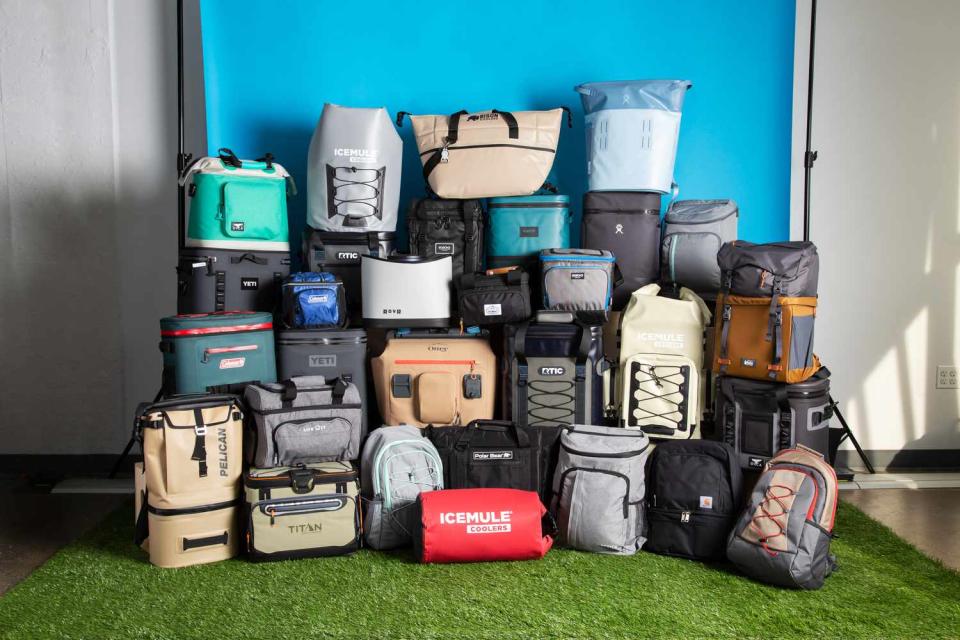
High-performance hard coolers from brands such as Yeti have raised the bar for what consumers expect (and what they expect to pay) from coolers. That shift has spilled over into the soft cooler category and has pushed quality soft coolers' performance (and price).
While it's easy to get caught up in wanting the best, being realistic about using your soft cooler can help you choose one that works for your intended uses. Coolers have come a long way since glorified bags that offer a few hours of chilling, but that now-quaint level of performance may be all you need.
Hard coolers are still the gold standard in cold-retention, but soft coolers provide distinct benefits, such as portability made possible by their lighter weights and flexibility. To find the right cooler, browse our tested recommendations and read our tips at the bottom of this article.
Editor's note: Please note that we previously recommended the Yeti Hopper M20 Soft Backpack Cooler, but it has been removed due to the March 9, 2023 safety recall.
Coleman High-Performance Leak Proof Soft Cooler with Ultra Thick Insulation
Best Overall

What We Like
Handles and backpack straps give two ways of carrying
Good thick insulation
Excellent value
What We Don't Like
Some water leakage
Coleman is probably one of—if not the most—popular budget outdoor gear brands. And its High-Performance Leak Proof Soft Cooler is an excellent value as it aced many portions of our test and is one of the least expensive coolers we tested. We could fit 20 cans easily in this 24-can cooler or 12 cans with snacks and food. The thick and durable insulation kept our drinks cold for many hours.
We love that this cooler has handles and backpack straps, making it ideal for different carrying methods. And we dig the bonus features like side pockets, webbing to attach gear to, and an attached bottle opener. Despite the product's claim to be a leakproof cooler, we did have some leaking. But it was minimal and basically a non-issue considering the cooler's price and how it faired in other portions of our test.
Price at time of publication: $65
Capacity: 24 cans (claimed) | Size: 13.5 x 9.13 x 19.13 inches | Weight: 2.51 pounds
IceMule Classic Insulated Backpack Cooler Bag
Best Value
For its cost, we don't think there's a better soft cooler on the market.

What We Like
Collapsible, lightweight, and comfortable on the shoulder
Very durable
Accessible cost
What We Don't Like
Not great cold-retention for 24 hours or more
If you're looking for a collapsible and durable option at a more affordable cost, we highly recommend the Icemule Classic. It isn't as comfortable on the back as Yeti's Hopper BackFlip. And it didn't hold the cold as well (the temperature inside the cooler rose about 18 degrees between two hours and 24 hours after putting ice in it compared to just 7 degrees for the Yeti). But our testers appreciated how comfortable the Classic is to carry on one shoulder, how light it was, and its durability.
Icemule uses a proprietary material it calls "MuleSkin" for a tough outer layer. That's combined with another proprietary insulation called a "PolarLayer." And while Icemule claims that combo will keep ice solid for up to 24 hours, we found that wasn't the case. Still, we don't think you can find a better soft cooler on the market for its cost.
Price at time of publication: $85
Capacity: 12 cans including ice | Size: 10.25 x 10.25 x 18 inches (closed) | Weight: N/A
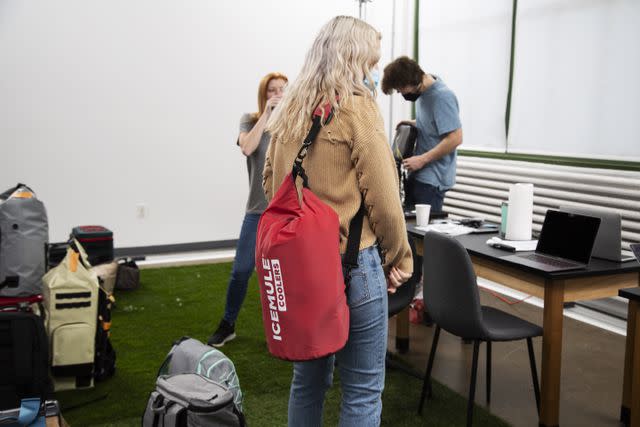
Igloo MaxCold Hard Liner 4.5qt Cooler
Best Budget
The 1.12-gallon volume holds about a dozen 12-ounce cans so it’s a great size for lunch for a small group.

What We Like
Affordable
Lightweight
What We Don't Like
Short-term cooling only
While pricier options like Yeti outperform cheaper alternatives, the amount of time many people use soft coolers is so short it’s hardly worth the expense for the extended performance. If your drinks need to stay cold until the end of the game, do you need ice to last for three days?
This MaxCold soft cooler from Igloo may not be a status symbol, and it won’t keep ice for days, but it’s a solid soft cooler from a longstanding cooler brand that doesn’t break the bank. The soft exterior holds a removable stiffer insulative liner that provides some structure and gives you confidence that your sandwiches won’t get crushed the second something bumps up against the cooler.
The 1.12-gallon volume holds about a dozen 12-ounce cans, so it’s a great size for lunch for a small group. Unlike more expensive, multi-day soft coolers, which can weigh 5 pounds or more, this Igloo offering is light: under a pound, making it easy to grab and go.
Price at time of publication: $30
Capacity: 4.5 quarts | Size: 10.5 x 10.75 x 7.75 inches | Weight: 0.95 pounds
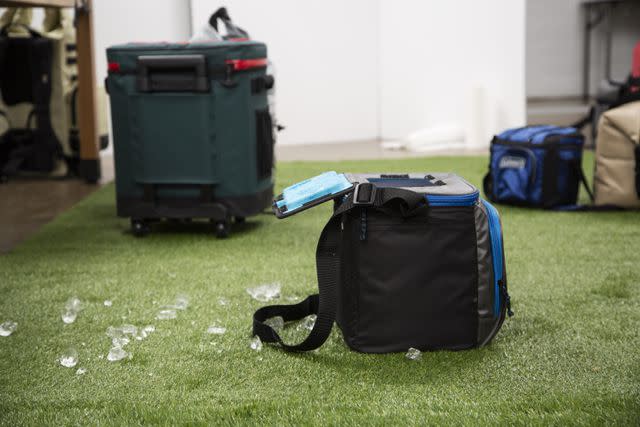
Related:The 11 Best Backpack Coolers of 2023, Tested & Reviewed
Orca Walker Tote
Best Beach Tote
The thick insulation also gives it structure so while it’s soft and flexible to carry, it protects contents and stays rigid.

What We Like
Stylish design
Strong cold retention
What We Don't Like
Bulky, doesn’t collapse
The beach can be one of the harshest environments for coolers: direct sun, high temperatures, sand, and water. Unfortunately, most beach tote-style coolers are not serious coolers and prioritize aesthetics over function. Thankfully, Orca’s Walker looks sharp and delivers cooling performance in an over-the-shoulder soft cooler tote. The cooler is built like an inflatable paddleboard with welded seams, a rugged rubberized bottom, and a stiff canvas hide. The thick insulation also gives it structure, so while it’s soft and flexible enough to carry, it protects contents and stays rigid.
While we tested during cooler fall temperatures, the Walker delivered days of ice retention versus the hours we got from flimsier bag-style soft coolers. Those times would be shortened in direct sun and high temps, but the thick walls of the Walker are more than enough for a day at the beach. In our lab, the temperature inside the tote actually dropped 8 degrees between two hours and 24 hours after filling it with ice.
It’s tall enough for wine bottles and can carry about 18 cans with ice, but it’s not so big you hate to carry it, and it only weighs 3.6 pounds empty. We also loved the magnetic handle closure.
Price at time of publication: $180
Capacity: 18 cans with ice | Size: 15 x 9.5 x 15.25 inches | Weight: 3.6 pounds
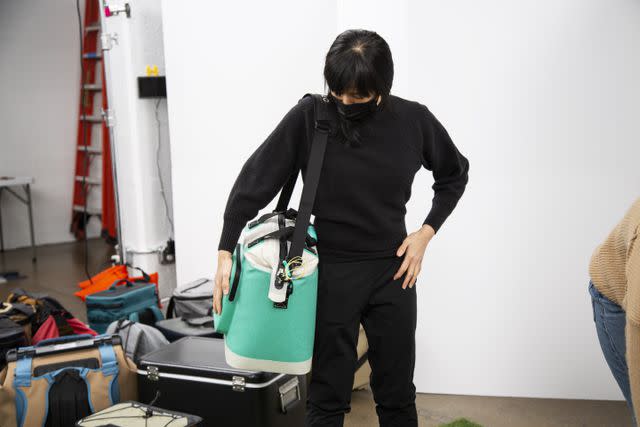
RovR KeepR + IceR Combo Insulated Tote
Best for Bartending
An open-top bar cart soft cooler designed for mixing drinks away from home whether at camp on the beach or a boat.

What We Like
Attractive design
Compartmentalized storage
What We Don't Like
Short-term only cooling
Drink slingers; look no further. Most soft coolers focus on toting cans and measure their capacities in can increments. However, the RovR KeepR focuses on mixology with an open-top bar cart soft cooler designed to mix drinks away from home, whether at camp on the beach or on a boat. Unlike most soft coolers, the KeepR is more of a cocktail caddy built around the IceR double-wall stainless steel ice bucket. Adjustable pockets not meant for cold-retention encircle the IceR. However, we recommend buying the sold-separately ChillR ice pack inserts, which slide into the compartments to keep bottles cold for shorter periods.
While the KeepR is an excellent drinks caddy, it’s also a perfect picnic option as you can still tote ice for cold drinks but use the compartments for utensils, dishes, and food for two or a small group. RovR even sells small SnackR food containers that fit neatly into the IceR, which can keep food hot or cold. Our testers liked how the ice consolidated in the center helped even out the weight and noted it was comfortable to carry by hand.
Price at time of publication: $160
Capacity: 10 liters | Size: 12 x 11 x 11 inches | Weight: 5 pounds
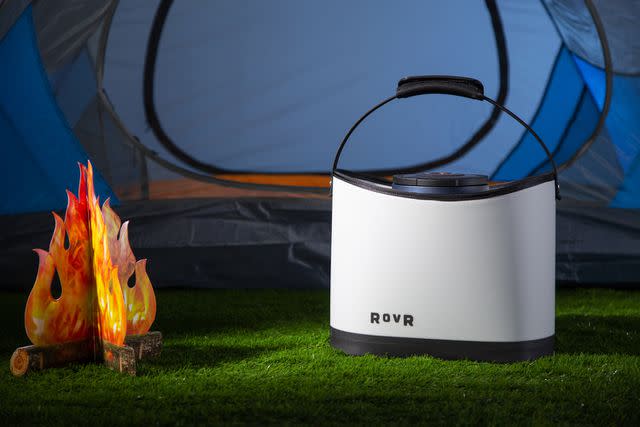
IceMule Pro Cooler 23L
Best for Paddling
A dry bag and hardside cooler combined to create an insulated, durable dry bag that’s perfect for a day on the water.

What We Like
Lightweight
Collapsible when not in use
What We Don't Like
Only up to 24 hours of cooling
Dry bags are a staple of river trips, as are heavy, bulky hard-sided coolers. The Icemule Pro essentially combines the two into an insulated, durable dry bag perfect for a day on the water. Like a good dry bag, the Icemule Pro has a roll-top closure that it claims will not let water in or out and allows you to trap air inside for extra insulation. Our testers noticed a bit of a leak from the roll-top closure when inverting the cooler. It also has the added benefit (significant on the water) of making the bag float.
The IceMule Pro doesn’t deliver multiple days of extreme ice retention, but it’s enough to get you through a hot day. When emptied, it’s much more collapsible than stiffer softer coolers meant to retain ice for multiple days—an important feature when conserving space in a boat or on a pack. Stiffer soft coolers are not collapsible and take up the same amount of space regardless of whether they’re in use. We tested the extra-large 33-liter size and the 23-liter large size, which is probably plenty for most people’s day trips. While perhaps not its most exciting use, we also found the Icemule Pro a great addition to grocery trips to keep refrigerated and frozen items cold in my vehicle.
Carrying it around was comfortable, thanks to the padded straps and chest and hip straps, and the weight was evenly distributed. Our testers also liked the spout for draining water.
Price at time of publication: $100
Capacity: 23 liters | Size: 17 x 14 x 11 inches | Weight: 3 pounds
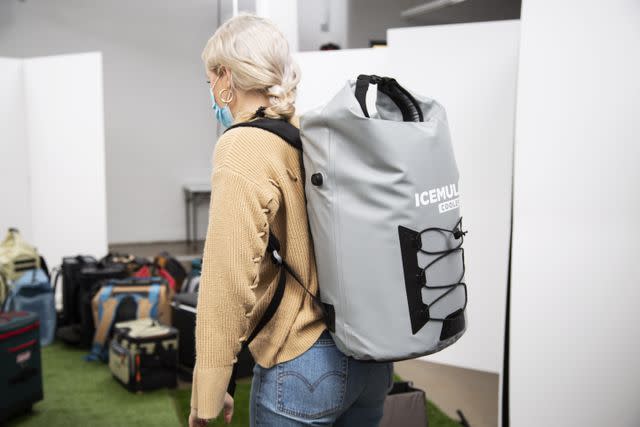
RTIC Insulated Soft Cooler Bag
Best for Road Trips
This cooler has the ideal size and cold-retention to be an ideal copilot.

What We Like
Similar performance to other top coolers but at a better cost
Excellent for road trips
What We Don't Like
Large and heavy
The RTIC Soft Pack Cooler has a similar feel and look to a Yeti cooler but comes at a more accessible cost. And there's not much difference in performance for the RTIC. A 2-inch closed-cell foam boosts the insulation—it only raised about 11 degrees between two and 24 hours of having it filled with ice during our lab test (compared to about 7 degrees for the comparable Yeti we tested).
While our testers noted this cooler is large and heavy and not the easiest to lug around, we also appreciate that the cooler floats in the water, is spill- and leakproof, and comes in four sizes. We also found it to be an ideal road trip size as it's small enough to fit easily into a car yet sufficient to carry drinks and snacks for a few people. We enjoyed using this cooler on a road trip from California to the Midwest and back to California and saw it as the perfect cooling copilot.
Price at time of publication: $130
Capacity: 12, 20, 30, and 40 cans | Size: 12 x 10 x 8 inches | Weight: 2 pounds
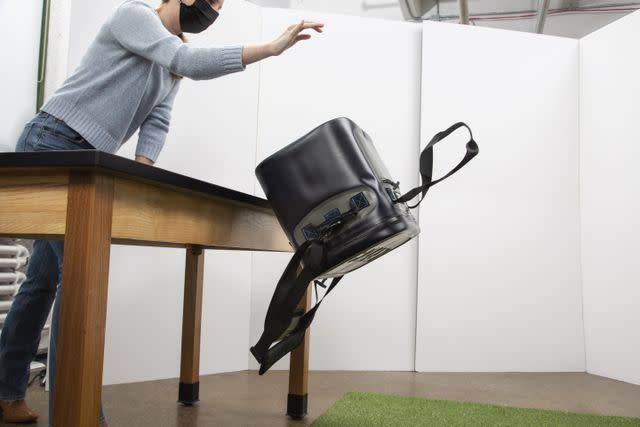
Orca Walker 20-Can Soft Cooler
Best for Boats and Beaches
We like the Orca for its durability, design, and aesthetics.
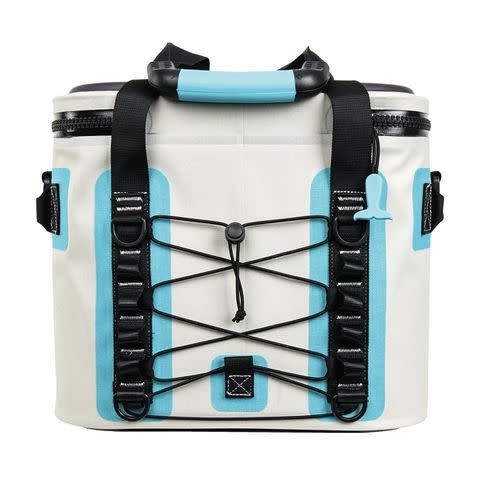
What We Like
Super burly and durable
Magnetic split handle is a nice feature
What We Don't Like
Didn't hold ice quite as well as the similar Yeti Hopper
Like RTIC, Orca has taken the soft cooler design many people associate with the Yeti Hopper and made it their own. Besides the fact it looks almost identical to Yeti's Hopper, it's got the same beefy construction with massive walls for insulation, burly denier on the outside, and an attachment system. But Orca has added innovations like the magnetic split handle and some newfangled welding adopted from whitewater craft construction. The result is one of our favorite coolers we tested that could probably be dropped from a five-story building with minimum damage.
Despite looking like a Yeti—and having thicker insulation on its lid (by half an inch)—it didn't quite have the same performance as the Yeti Hopper. At the end of our 24-hour ice test, the Orca had no remaining solid ice, while the Yeti had some. And where the Yeti's inner temperature increased by about 6 degrees over 24 hours, the Orca's went up by about 13 degrees. Still, if you're looking for a cooler that has the aesthetics, design, and durability of a Yeti but don't want to spend quite the amount (we don't blame you), the Orca is a solid alternative.
Price at time of publication: $200
Capacity: 20 cans | Size: 14.5 x 11 x 13.25 inches | Weight: 3.6 pounds
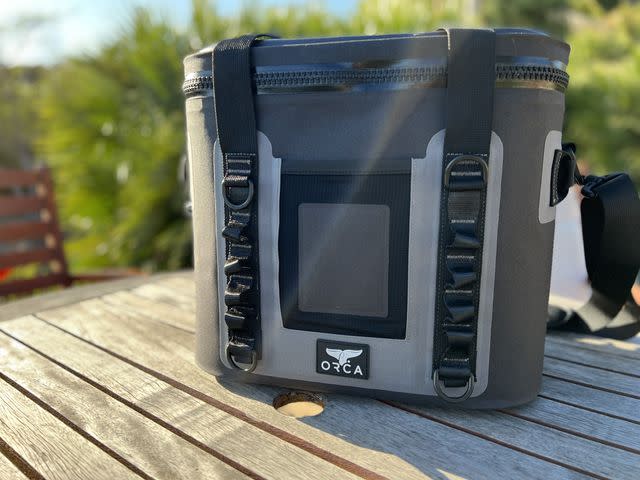
Yeti Hopper Flip 18 Insulated Personal Cooler
Best for Fishing
This classic from Yeti is ideal for fishing, camping, road tripping, beach days, and any general outdoor activity.

What We Like
Cold- and ice-retention is top of its class
Great size for a day trip for a few people or overnight for a couple
What We Don't Like
Testers though there could be more padding on the shoulder strap
The Yeti Hopper Flip series is a classic line of soft coolers. Yes, it's expensive. But as long as you don't drop it off the south rim of the Grand Canyon, you're likely to have this cooler for a very, very long time. We had no problem filling the cooler with 20 cans and plenty of ice. And not surprisingly, it had some of the best ice retention and coldest temperatures at the end of our 24-hour test. The Hopper Flip's inside temperature only raised by about 6 degrees over 24 hours, thanks to Yeti's closed-cell insulation, for which it's become infamous.
Besides its ability to hold cold temps and ice for days, our testers liked the size and shape of the cooler. They also liked how leak-proof it is and the two handles on each side of the cooler's body. However, they were not impressed with the lack of padding on the Hopper Flip's shoulder strap and how heavy it was (it's about 1.5 pounds heavier than the similar Orca Walker 20-Can).
We've taken this cooler and Yeti's BackFlip 24 on many fishing and fly-fishing trips. We like the Hopper Flip because of its size and ability to keep drinks cold all day, even in the warm sun. It's the perfect companion and size for a group of three or four to have a few cans each throughout the day.
Price at time of publication: $300
Capacity: 20 cans | Size: 10.75 x 13 x 16.25 inches | Weight: 5.1 pounds
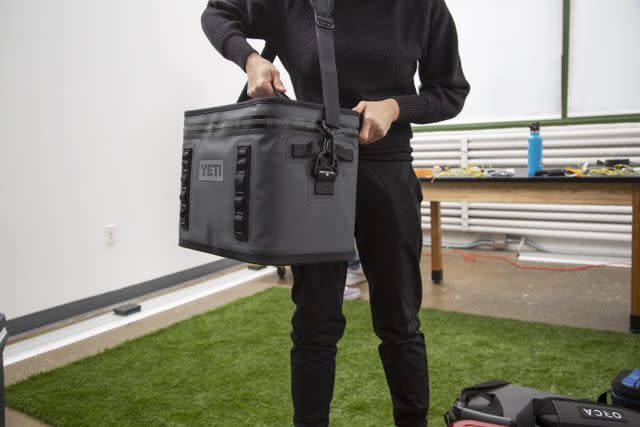
IceMule Boss 30 Liter Backpack Cooler
Best for Day Hikes
This beefy and rugged backpack cooler could probably fall off a mountain and be fine.

What We Like
The most comfortable large backpack cooler we tested
Super durable and rugged
What We Don't Like
Didn't hold cold and ice as well as the Yeti
We didn't throw this backpack cooler off the side of a mountain (yet), but we probably could, and it'd be fine. Icemule's Boss Backpack Cooler is incredibly rugged and has some serious insulation. "The design reminds me of a single big backpack that people use for backpack travel," is how one of our testers put it. Icemule uses proprietary fabrics, welded seams, and extra-padded straps to make this one heavy-duty yet comfortable backpack. Our testers loved this pack's comfort compared to other large backpack coolers, thanks mainly to the extra padding and chest and waist straps.
While the Boss is very durable and comfy to carry, it didn't do as well in ice and cold retention compared to Yeti's Hopper BackFlip backpack cooler. Some 24 hours after we put ice in the coolers, the inside temperature of the Boss increased by 19 degrees compared to just 7 degrees in the Yeti. And where the Yeti still had about half of its ice frozen, our testers reported only about 20 percent of the ice placed in the Icemule stayed frozen.
Still, this is the one for you if you're looking for a cooler that will keep your drinks and food cold—and your shoulders and back comfortable—while going on a day hike.
Price at time of publication: $375
Capacity: 24 cans | Size: 12.5 x 9 x 25 inches | Weight: Not listed
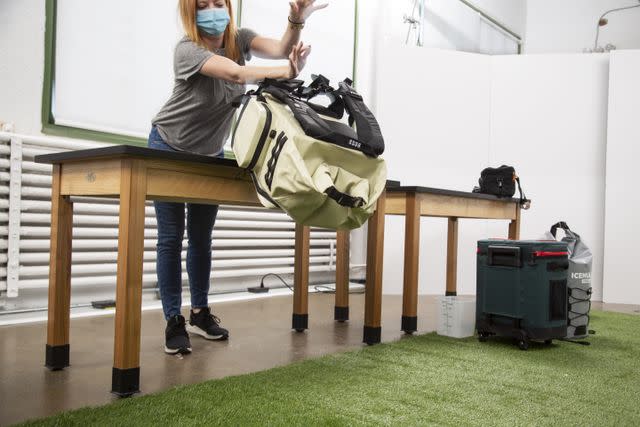
Arctic Zone Titan Deep Freeze
Best for Picnics
Organization chops and excellent cold-retention make this our top picnic pick.

What We Like
Excellent organization
Strong cold-retention
What We Don't Like
Zipper-less design can pop open easily
We love the Titan Deep Freeze cooler from Arctic Zone for car camping and picnics. Besides having some of the best cold-retention (more on that in a bit), the Titan has some excellent features for picnic organization. We dig the "HardBody" liner that comes out of the cooler and can serve as a shelf or table. We like the side mesh pockets to store utensils, napkins, or other picnic items that do not need cooling. And we like the bottle opener.
But what impressed us most was the cold retention of the Titan. Some 24 hours after we put ice into the Titan, the inside temperature only raised 5 degrees—better than both Yeti coolers we tested. There's no zipper on the lid—just a Velcro-like closure—so be sure the cooler stays upright in transportation. And while it claims to hold 30 cans with ice, we found it much easier to fit 20 cans with adequate ice. Still, we didn't find a much better option for your picnic outings.
Price at time of publication: $80
Capacity: 30 cans | Size: 12.25 x 8 x 12.25 inches | Weight: 2.9 pounds
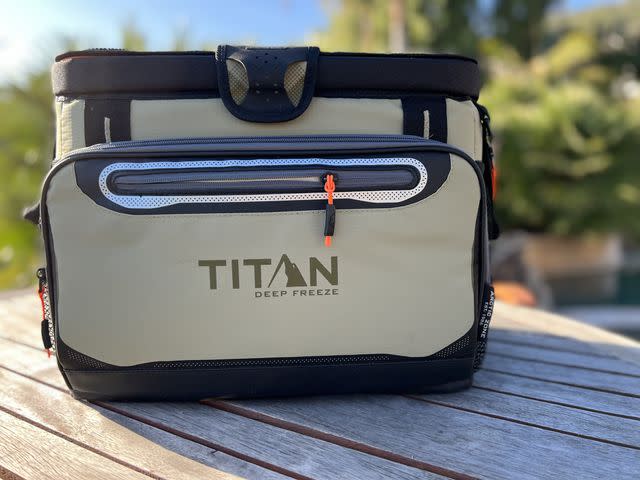
Polar Bear Coolers Original Nylon Soft Cooler
Best Lunchbox Cooler
Polar Bear's Soft Cooler had some of the best cold retention among all coolers we tested.

What We Like
Excellent cold-retention
Great portability with short handles on top and a shoulder strap
What We Don't Like
Leaked a lot from the zipper
Polar Bear's Original Nylon Soft Cooler was one of the most portable and best at cold-retention among all coolers we tested. Our testers loved the short handles on top of the bag and included shoulder strap. "It feels like a large tote bag and carries like one," is how one tester put it. The inch of high-density insulation worked very well in our cold-retention test as the temperature inside the cooler only increased by about 2 degrees over 24 hours, and only about half of the ice melted during that same timeframe.
One potential issue, especially when transporting for lunch, is the cooler leaked a bit from the zipper. We recommend avoiding holding it upside down when possible. Four tie-down points on the cooler will help with that during transport in a vehicle.
Price at time of publication: $90
Capacity: 12 cans | Size: 20 x 15 x 6.5 inches | Weight: 2 pounds
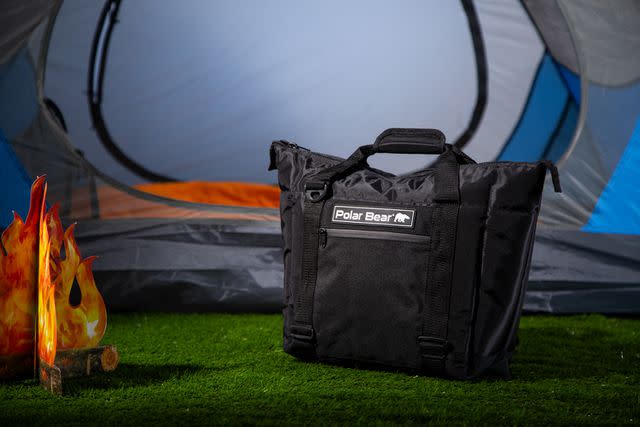
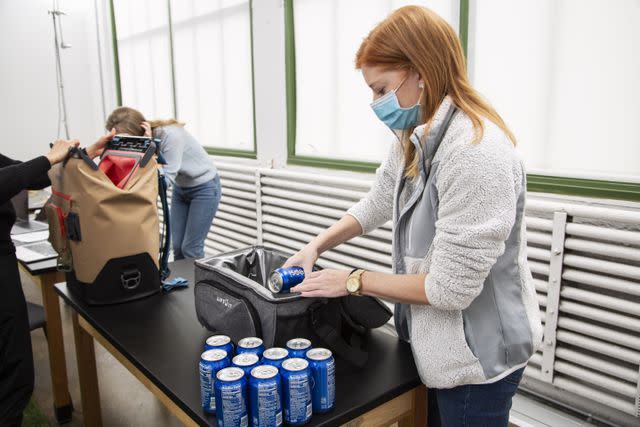
Other Coolers We Tested
Yeti Hopper BackFlip 24 (view at Amazon): Yeti has become the standard in modern coolers. And one of their best is the Hopper BackFlip 24. Yeti uses closed-cell rubber foam to boost its cold-holding ability. The Hopper BackFlip also uses high-density fabric to make it incredibly rugged. That cold-holding ability and solid construction make Yeti soft coolers so popular—despite their outrageous cost—and one of the most popular on the market. When we did a two-hour and 24-hour temperature test in our Brooklyn lab, the temperature only increased by 7 degrees between two and 24 hours. When we finished testing, the Hopper BackFlip had one of the best ice to water ratios.
Yeti claims the Hopper BackFlip 24 can hold 20 cans at a two to one ice ratio. We found it much easier to pack 16 cans with adequate ice. And while our testers said the space inside the cooler didn't feel as big as it should be because of the outside size, it fit securely and comfortably to their backs, especially compared to smaller coolers we tested.
This cooler is expensive. But if you view it as your long-term cooler companion, it's worth its high price. We've taken it to campsites, beaches, and potlucks with friends and family, and it's been appropriate in all settings.
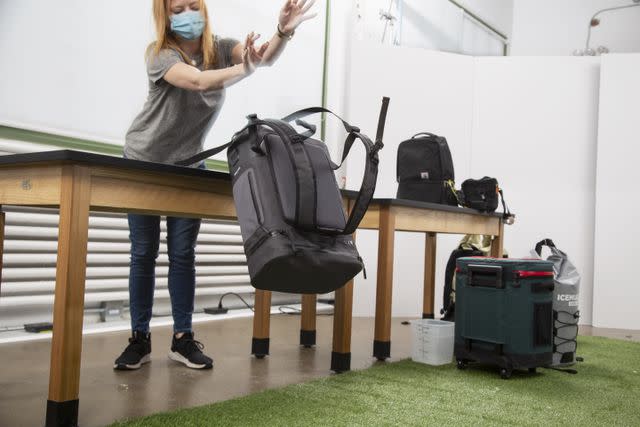
Bison Coolers SoftPak (view at Amazon): Our testers loved this cooler. We maxed it out at its recommended 24 cans and had room left for ice and even more cans. Our testers liked the light exterior color and waterproof nylon, making it easy to clean. It also has very thick padding and a 1,000 denier vinyl shell. The testers loved the tote bag shape and how it closed on both sides. However, they weren't down with the thin-padded shoulder strap and how it dug into their shoulders.
Coleman 9-Can Soft Cooler (view at Amazon): If you didn't like the best lunchbox pick above, this less expensive Coleman could be a solid backup. Our testers liked how it resembles a lunch pack and enjoyed the sturdy plastic insert, which was easy to take in and out and helped the cooler hold its form. They also liked how easy this was to carry around. But we found it difficult to fit any more than six cans with ice and had issues with water leaking out the side when tipped.
Coleman 42-Can High-Performance Leak Proof Soft Cooler (view at Amazon): Our conclusion on this cooler was that you could do better for the price. It's not to say this is a bad cooler. It just didn't perform as well as the others we tested. First, we could only fit up to 30 cans (not 42) with minimal room for ice. And while our testers liked the interior color and thick padding, the nylon exterior got dirty and marked up quickly. The cooler also leaked a bit through the zipper when tipped.
Poler Classic Camera Cooler Bag (view at Sierra): We had high hopes for this cooler bag because we've recently loved Poler products and the uniqueness and innovation in this particular bag. But we found that it wasn't possible to store both a camera and beverages simultaneously in this two-in-one bag. Our testers also had issues with how thin the insulation was and how much the cooler leaked. "Comfy to carry but pointless as a cooler," is how one tester harshly put it.
Lifewit Soft Cooler Bag (view at Amazon): "Super portable but not ideal with ice" is how one tester succinctly described this cooler. Simply put: This cooler leaked a lot. It leaked when carried around our testing lab. It leaked when tipped a bit. Our tester's pro-tip if you decide to purchase this soft cooler is to use ice packs instead of loose ice to help mitigate that leakage.
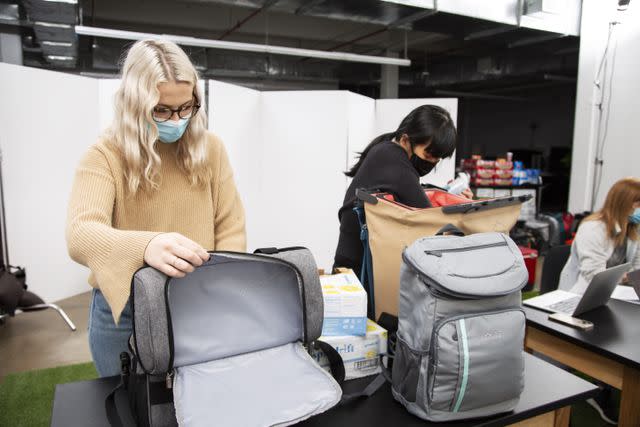
Product Selection
We combined our product expertise, research of other sites creating the best soft and backpack coolers lists, and top-selling items on popular sites like Amazon, Walmart, and REI when creating this list. Some of these coolers our editors and experts have used for multiple years. Others were new to us. All have been featured on other sites or are top sellers on major e-commerce sites.
We also wanted to pick a diverse list is prices, functions, and specialties. From there, we purchased the best 30 coolers we could find to take to our lab in Brooklyn for testing.
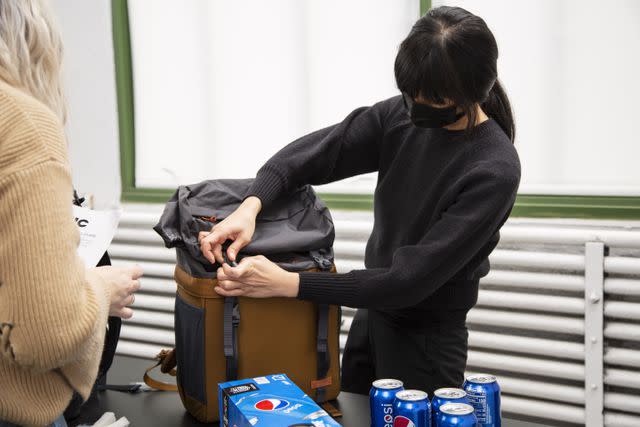
How We Tested
All coolers were tested extensively in our Brooklyn testing lab. We then sent the coolers to field testers for additional insights. We packed the coolers with the stated capacity of cans (when possible); we also filled the coolers with ice once the cans were packed. Once the coolers were full, we began testing for portability and durability by carrying the coolers around the lab and up and down steps and pushing them off tables onto a concrete floor.
We also measured for cold and ice retention by taking the inside temperature of each cooler at two hours after filling them with cans and ice and then 24 hours after filling them with cans and ice. We also observed how much of the ice melted after 24 hours.
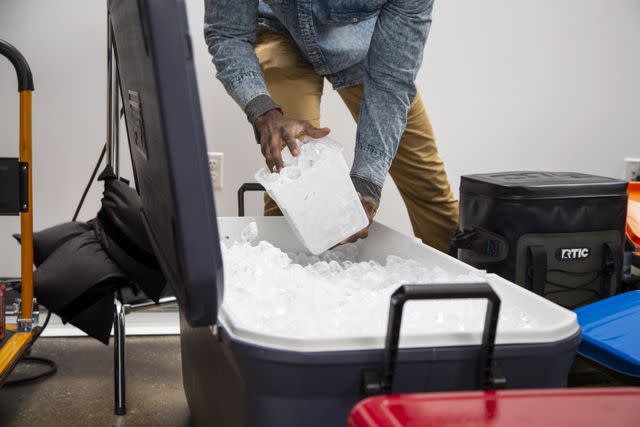
What to Look for in a Soft Cooler
Ice Retention Claims
One of the hardest things about comparing coolers is that it’s tough to compare the cooling performance by a standard measure. Some brands estimate how long ice will last, but that number is dependent on ambient conditions and cooler contents, among many factors. Yeti is one company that doesn’t make any claims about how long ice will last in a particular cooler. Their explanation is genuine and helpful to understand: “Due to all of the variables that affect ice retention, and because every adventure is different, we believe it is misleading to make specific claims about how long a cooler will hold ice.”
While they’re not standardized measures, we have found that most cooler companies’ estimates of their cooling power are reasonably helpful for rough comparison. A soft cooler that claims 24-hour ice retention is usually lighter duty than one that claims three days or more. You should never consider these numbers as performance guarantees, but as a crude spec to gauge where a cooler stands within the category, I find the estimates useful. The stated numbers are often something qualified, such as “keeps ice cold up to 36 hours,” and you should assume any ice retention claims to be best-case estimates and that performance will be worse in less than ideal conditions such as high temperatures and direct sun.
Price
The price tags on modern soft coolers may be shocking if you haven’t shopped for one before. Most higher-end offerings are well over $100, and the top-of-the-line options are as much as $300 or more. If your budget is tight or you aren’t sure you need the best soft cooler around, consider some of our lower-cost recommendations. If you don’t need multiple days of cooling performance, cheaper coolers are less of a budget ding, and they’re often more comfortable to use and carry due to their more flexible structure and lighter weights. However, the cheapest coolers often don’t deliver much cold-retention, so we’d steer clear of the most inexpensive options as they are often not much better than a thick bag or backpack that you may already own.
Capacity
Capacities in a soft cooler are often stated in sheer storage capacity listed in various volume measures such as gallons, quarts, or liters. Many companies also list capacity in terms of the number of cans, which can be easier to visualize.
While the can measurement standard is helpful, keep in mind you'll need to devote at least some of that volume to ice. The amount of ice you put in a cooler is totally subjective and depends on how cold you want the cooler's contents and the conditions and temperatures in which you'll be taking the cooler. Just make sure to read the specs carefully and assume that max can carrying capacity listed is for only cans in most cases.
Ease of Use and Portability
The benefits of a soft cooler are flexibility, lighter weight, and portability compared to hard coolers. Still, as you add insulation thickness and rigidity to improve performance, those benefits start to diminish. It’s hard to gauge how stiff or user-friendly a soft cooler might be from a product description since few manufacturers list the thickness of their cooler’s walls in their specifications. Getting your hands on a cooler is the best way to assess this somewhat subjective factor of how comfortable it is to carry and how rigid it might be, but you can use the listed weight as a good proxy for how thick the insulation is. Many longer-lasting soft coolers weigh between 5 and 10 pounds, which gets heavier as you add heavy liquids and ice. Consider how long you need a cooler to retain cold and how far you might be carrying it on an average outing as you balance weight and performance concerns in your purchasing decision.
Frequently Asked Questions
Are soft coolers as good as hard coolers?
Hard coolers usually deliver the best cold-retention as they often have extra-thick walls, rigid construction, and solid seals. Soft coolers are popular because they provide cold-retention in a more user-friendly format with coolers that are more flexible, lighter, and easier to carry. Many can be worn as a backpack or slung over a shoulder. Heavy-duty hard coolers usually need wheels or two people to hold them and are limited in how far you can travel without a vehicle.
Neither type of cooler is “better.” Hard coolers work well when you need long-lasting cooling and don’t need to carry them much more than a hundred yards. They’re also great to double as seating when car camping or boating, unlike soft coolers, which are usually just bags. Soft coolers are “better” if you need something lightweight or just want something more straightforward and don’t need a week-plus of cold retention. Some soft coolers are collapsible, making them ideal for constrained journeys where space is at a premium and can be conserved by compressing the cooler when not in use.
Do soft coolers leak?
Good ones don’t! Most modern soft coolers have watertight zippers and seals, and openings that close with robust mechanisms. Most quality soft coolers also use materials and construction that avoid seams and junctures that could provide opportunities for leakage.
Still, the durability prize goes to hard coolers, so if you have zero tolerance for leakage and want to abuse your cooler and still get leak-proof performance, consider a hard cooler for your needs.
Why Trust Tripsavvy
Justin Park is a Breckenridge, Colorado-based writer and videographer covering action sports, health & fitness, and the outdoors. From multi-day backpacking and hunting trips to simple road trips to weeks on Lake Powell in 100+ degree temperatures, he's dependent on quality coolers in the field. He currently likes the Hydro Flask Day Escape 20L for quick road-tripping and the Yeti BackFlip for more serious cooling on the go.
Nathan Allen is TripSavvy's outdoor gear editor. A lifelong user of coolers, he appreciates the innovation of soft backpack coolers. For a few years now, Nathan has loved his Yeti Hopper BackFlip and Yeti Hopper Flip, but the Icemule cooler packs mentioned in this roundup are quickly becoming his new go-to's in certain situations.
A team of editors and testers from TripSavvy and Dotdash Meredith's food group sites like Simply Recipes, Serious Eats, The Spruce Eats, and Liquor conducted testing in our Brooklyn lab.
Up Next:The 11 Best Backpack Coolers of 2023, Tested & Reviewed

